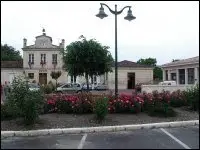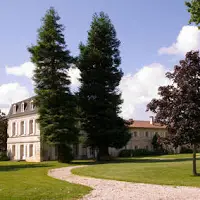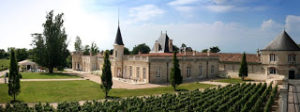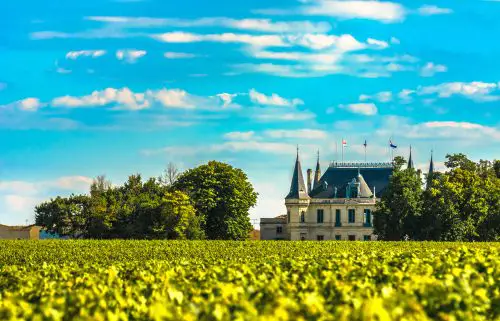Mention Margaux and wine  lovers will immediately think of Chateau Margaux – the only Château that has the unique privilege of bearing the name of its appellation.
lovers will immediately think of Chateau Margaux – the only Château that has the unique privilege of bearing the name of its appellation.
The château has a prestigious past which stretches back to the 12th Century when it was known as La Mothe de Margaux. La Mothe comes from the French word motte, meaning a small rise in the land.
The château is believed to have once been the residence of Edward III, King of England, and was one of the most stately fortified châteaux in Guyenne.
The château that we see today was built by the Marquis of La Colonilla when he acquired the estate in 1804.
The château was built in neo-Palladian style between 1810 and 1816 and is the most important neoclassical building of the Bordeaux area.
and 1816 and is the most important neoclassical building of the Bordeaux area.
It was designed by the architect Louis Combe on four levels and the wine cellars are 100 metre-long and 23 metre-wide.
The appellation Margaux encompasses 5 communes: these are the village of Margaux and the neighbouring villages of Arsac, Labarde, Soussans and Cantenac. It is the most southerly of Médoc’s appellations and extends over 3,200 acres with 80 châteaux and domaines who produce wine.
It boasts 20 of the original 61 classified growths from the 1855 Classification of Bordeaux wines. Margaux is actually unique in the Médoc in that it is the only one to contain all the range of wines, as rich as they are vast, from First Great Cru Classé to the Fifths, not forgetting its famous Crus Bourgeois and its Cru s.
s.
The commune (village) of Margaux lies along the estuary of the Gironde, covers 737 hectares.
Has only around 1500 inhabitants and has its roots in Gallo Roman times. The name “Margaux” is believed to have originated as early as the fourth century, suggested by documentation in the letters of the poet Ausonius.
He refers to the “Thermes Mauojaliques,” also known as “Marojallia,” and evidence infers that Margaux was at that time a favourite thermal bath of the Gallo-Roman legions stationed near Ausonius’ residence on the opposite side of the river in Saint Emilion. Later place-name variations such as “Magnole” and “Marganac” clearly suggest the present form “Margaux”.
clearly suggest the present form “Margaux”.
Rather appropriately there is a modern spa at Margaux nowadays called The Relais de Margaux. Once a wine producing chateau founded by the Vincent de Cantenac family, The Relais de Margaux was used as the actual cellar for Chateau Margaux until 1984. It was transformed into a luxury hotel with a golf course and spa in 1985.
There is also a Chateau Marojallia which lies at the entrance to the village. The chateau has been making a garagiste wine since 1999. The wine produced has been described as Médoc’s first “garage wine”.
Located between châteaux Le Tertre and Monbrison, Maro jallia was founded in 1999 when the plots of Roger Rex were sold to Philippe Porcheron, and developed by Muriel Thunevin, wife and partner of Jean-Luc Thunevin, the team behind Saint Émilion’s Château Valandraud.
jallia was founded in 1999 when the plots of Roger Rex were sold to Philippe Porcheron, and developed by Muriel Thunevin, wife and partner of Jean-Luc Thunevin, the team behind Saint Émilion’s Château Valandraud.
With Muriel Thunevin responsible for the 1999 and 2000 vintages, Porcheron has made the wine since 2001. Michel Rolland is retained as consultant oenologist.
Margaux itself is well worth a visit, the village is pretty and there are plenty of surrounding châteaux to visit. The Medoc Tourism Office link is here and the address of the Mayor’s Office (Mairie de Margaux) is 12 Rue Trémoille, 33460 Margaux, tel +33 5 57 88 71 36.

